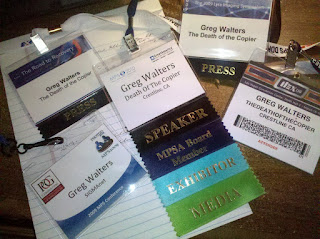"Greg, what were the biggest events or issues from last year?'
This year, like last year, my initial reaction is, "Not much." Which is soon followed by a wave of angst....a seasonal tradition.
Most of the industry is insane.
OEMs keep releasing new models...which aren't all that new...like it's 1999. Mobile print, document management, managed print services, automatic toner replenishment, managed services, and that fictitious managed network services are all the 'rage'. Same as last year.
The consolidation continues as dealer after dealer is gobbled up by yesterday's rival or taken over by a capital investment firm. Same as last year.
Clients aren't making copies and office print is on the decline. Same as last year.
But there are golden nuggets in 2015; it wasn't simply the "Year of Tears".
1. HP Split - Jettisoning print
This was no surprise.
I believe the world of print is heading into HP's wheelhouse - smaller devices, low operating costs, and direct supplies management.
Managed print services is not complicated. When considering the influences, especially MPS automation, there's no need for a dealer. With today's technological advances in M2M, a national company can provide toner and service more efficiently than a 'local' reseller.
Someday, HP will deliver MpS anywhere in the country - without a local service network. No need for a middleman.
The split is good for HP, not sure if it's good for the channel.
2. The Sunset of An Industry
Xerox is in decline and Icahn, the Master of Disaster, buys more and more. He's going to oust Ursula then slice and dice the Big X - another Kodak moment.
Meanwhile, Lexmark the wallflower, hikes up her skirt, beguiling suitors with promises of MpS, revenue streams. Multiples are good, but who's going to ask Lexi to dance?
HP's vision, as mentioned above, is one of continuous transformation. As business evolves, and technology removes the mundane components, like print, loud, hot, expensive machines designed to make marks on paper, lose relevancy.
Consultants still place the OEMs in the upper right and tag big spenders as 'visionary' - whoever has the largest marketing budget or the nicest rooms in town, gets the best reviews and accolades.
Elsewhere, offshore concerns are marching to the 'print/copy is relevant' drum, churning out devices like crazy.
All points Terminus. Like Childhood's End, one day, the memory of a once great paper-making machine will be remembered in song, not substance.
3. Epson: Shining Star, for you to See
Yes, I mocked the hell out of the 'bags of ink'. But I poke fun at those who attract. You should consider Epson for the following reasons:
- De-emphasize print - I know it hurts, but the print is not all that important, and the walk-up copy is dead(except for SLED) in the end, print is simple because fewer people print. Why fight the trend? You cannot win. Epson takes the complexity out of printing with this device Just sell it.
- "Close and forget" mentality - Imagine a device that requires one or two touches a year and one toner delivery every three years. Quick, do the math. Get a good chunk of margin up front, put the device on MpS, and forget about it.
- No technicians, no toner delivery, just monthly billing - That's all.
You could have been part of that movement. You could have been telling your clients how to reduce the cost of print by decreasing the number of print servers. You could have elevated the MpS discussion above and beyond toner and service calls. You could have sold a bunch of stuff, too.
But you didn't and now you've lost a bunch of accounts.
Boo, f'n, who. If you're not retiring or selling out, get on the ink-bag train. Call Epson, now, but it might be too late.
10 Years Out -
What is the future of print, in the year 2025? No business print. Little in education, more in government, and healthcare will be paperless.
The Internet of things will be the Internet of everything - plants will talk with light bulbs which will communicate with coffee tables, the paint on your walls, and your inhaled nano's. Everything, everyone will be connected, all the time.
Information will finally move at the speed of thought.
How about in the year 2020? Just like the computer dealers of the 1980s, copier dealers will fade into history. Few copier dealers will remain.
Eric Church - Mr. Misunderstood
Click to email me.





































